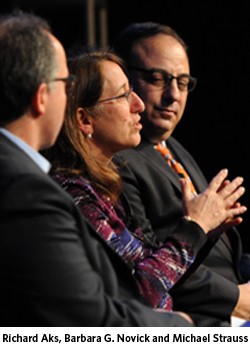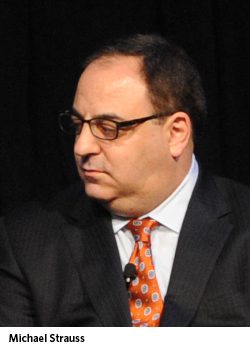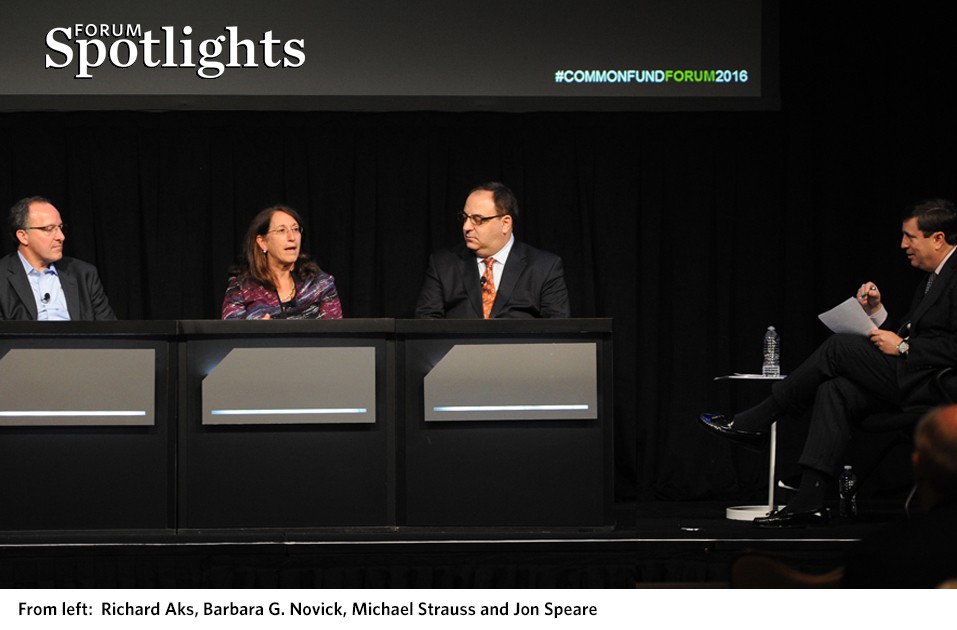In the static low-rate environment of recent years, it seemed as though there was no “what’s next” for cash. Today, that has changed, as there are major forces reshaping the regulatory and interest rate regimes.
At Commonfund Forum 2016, a panel of experts exchanged viewpoints and experiences regarding cash management and the issues treasurers and CFOs confront on a regular basis in the current environment. Excerpts from the exchange follow. The discussion was moderated by Commonfund Managing Director Jon Speare. The panelists were Richard Aks, Vice President for Finance and Associate Treasurer, Rutgers University; Barbara G. Novick, Vice Chair, BlackRock; and Commonfund, Chief Economist, Commonfund.
Jon Speare: Finally—there’s something next for cash. We’ve had eight years of discussing “what’s next” and always came away saying, “Well, we’re still where we’ve been.” Now, what’s next includes both regulatory changes and interest rate risks. Today, we want to talk about what’s next for cash but broaden it to include operating assets as well.
Speare: Barbara, can you sum up what has happened in the regulatory environment . . . that is, condense eight years into a few minutes?
Barbara Novick: So, the Reader’s Digest version of multiple years of conversations? If you think back to the crisis, there was a problem in the market. Liquidity had dried up. Institutional Prime Money market funds broke the buck and experienced a run. Interestingly, though, government funds actually saw inflows and retail funds for individual investors didn’t see much activity at all.
Coming out of the crisis, you knew something was going to change and, in fact, something needed to change. Soon after, you had a joint regulatory and industry initiative, which culminated in the 2010 reforms in which the SEC announced changes to credit quality, maturity, liquidity provisions, minimum cash and transparency as well as stress testing.
In many ways, people in the industry felt it was a collaborative effort and that enough was done. But if you watched the actual rolling out of that final rule, the chair of the SEC at the end of the process said, “This is phase one. We will be back to talk about phase two, which will address the structural reform of money market funds.” So, this was just the first leg in the rules change.
The second leg was much more complicated, and I remember speaking at a conference where I thought I might have rotten tomatoes thrown at me because I said that there had to be change and that people were being somewhat foolish if they thought the situation was going to stay the way it was.
One of the problems was that each firm with money market funds had a different capital structure, so they each had different ideas of what would be good for their business. In addition, each regulatory agency that was involved had different ideas about the funds as well. Compounding it was the fact that nobody had actually done a data- driven analysis of what happened during the crisis.
 So, there was a lot of emotional reaction. You sift through it all, and you get to the end of SEC Chair Mary Shapiro’s tenure, when the economic division of the SEC was allowed to release a report showing the actual data, which was very compelling. Government funds had inflows. Retail funds had virtually no flows. And institutional prime funds had significant outflows. Without the insurance program that had been set up on an emergency basis during the crisis, more funds probably would have broken the buck. Clearly, action was warranted.
So, there was a lot of emotional reaction. You sift through it all, and you get to the end of SEC Chair Mary Shapiro’s tenure, when the economic division of the SEC was allowed to release a report showing the actual data, which was very compelling. Government funds had inflows. Retail funds had virtually no flows. And institutional prime funds had significant outflows. Without the insurance program that had been set up on an emergency basis during the crisis, more funds probably would have broken the buck. Clearly, action was warranted.
The question was, What action? Was it capital? Was it liquidity? Was it something else? This is where the different agencies got involved. The Fed raised concerns about money market funds. The SEC created money market funds, so clearly wanted to protect the product. Everyone else had differing opinions.
When you got through the whole thing and you saw this data, you came to recognize that you can love the final rule, hate it or just think it’s okay. I think it’s okay. It reflects what really happened in the crisis. So, in the move to a floating NAV, it’s likely to float very, very little. And if that’s what it takes to make sure that you don't have a run or a crisis or first mover advantage or other issues, that’s not a bad outcome. Likewise, government funds can be exempt, and the same thing with the retail funds. What followed was a transition period. The rule came out a year and a half ago, and we’ll have until October to change lineups, merge funds or convert funds. There are a lot of things going on, but I think where we ended up is a reasonable outcome given the data.

—Barbara Novick
Speare: Thanks Barbara. That’s a great summation. Michael, on the capital markets side: this is a $3.5 trillion issue. Did these discussions or changes alter the capital markets or the monetary policy shaping them?
Commonfund: They didn’t change monetary policy. They may change the sensitivity or reaction to future monetary policy. But what they did change is investor appetite for these three investment pools, if you want to call them that. We’ve already seen the effects of what will come on October 1—when the new rules go into effect— such as more flows into government funds and outflows from institutional money market funds.
Part of the concern may be that institutional investors may be uncertain about how they’re going to account for what is a very small change in the floating NAV. That uncertainty has gotten investors in the money market space to reduce allocations to institutional-only money funds.
As far as monetary policy is concerned, it suggests that if we look not at the next six to nine months, but out over the next five to 10 years, monetary policy may have a faster adjustment process through the money market arena—because if the Fed moves too quickly one way or the other it may change the par value of institutional money market funds. As an example, if rates were at 4 percent and the Fed very quickly cut rates to 2 percent, would we see values above par and inflows as institutions try to capture that capital gain? Conversely, if we were at 1 percent and the Fed very quickly went to 3 or 4 percent, would there be some capital impairment because of a quicker adjustment in money market yields, which would cause a potential decline in money market funds and, therefore, an exodus? You could argue in theory that these rule changes may make the front end of the market a little more sensitive to future monetary policy actions.
Speare: Richard, you have to use these programs. Was this a major change for you at Rutgers in terms of how you approach safety, liquidity and return?
Richard Aks: We’re going to need money market funds in some form, and obviously the first question to answer was, do we continue with prime funds? That’s a decision that we’ve made and don’t want to wait until the run-up to October 1.
There’s actually a broader set of regulatory issues that we’re facing. First, prior to the crisis, issuing variable rate debt and accessing bank liquidity were very inexpensive, and this made something like asset-liability matching a little easier because you could access the variable rate market and keep some assets in a floating rate investment. That's been challenged by the changing financial condition of banks and the Basel III reforms as well as by the fees banks are charging for liquidity. All that has made variable rate debt potentially less appealing over the long term.
Lastly, I would argue that there is another form of regulatory impact—the rating agencies, which post-crisis have adopted a metric that is designed to ensure that universities, for example, have adequate liquidity in the event of another liquidity crisis. The metric is days’ cash on hand, which really came out of the health care world. I’m not so sure that’s the right metric for a university, but those are some of the challenges that we are facing in terms of figuring out how much liquidity to maintain and where to invest it.

—Richard Aks
Speare: So, take the next step: Would you consider prime funds in light of that floating NAV?
Aks: To be honest, I'm not really sure how that’s going to play into our financial statements, and there are other impacts to consider. I don't feel like I want to be in there during the run-up up when institutions may be exiting. We might reconsider it after October October 1.
Speare: So, what is Rutgers doing in this era of change? How do you deal with essentially getting no return for day-in/day-out cash?
 Aks: In my view, liquidity is costing us money and we have to get around that. So, first of all, we go through a fairly extensive process, which is familiar to most people, of trying to identify our core cash, our contingent cash and what we actually need to remain liquid. Then we start to stratify our investments, looking at both external and internal opportunities.
Aks: In my view, liquidity is costing us money and we have to get around that. So, first of all, we go through a fairly extensive process, which is familiar to most people, of trying to identify our core cash, our contingent cash and what we actually need to remain liquid. Then we start to stratify our investments, looking at both external and internal opportunities.
One of the things we’ve done is put more money into our endowment. This offers one very big positive in the short term. The payout from our endowment is 4.275 percent of the trailing 13 quarter average. That’s higher than other fixed income types of investments we could make, even taking on some duration and credit risk.
Another thing that we’re doing is investing in ourselves to a certain extent. We can put cash that’s been sitting idle or invested short term and lend it out to units within the University for capital projects. We’re charging them our blended cost of capital plus a spread. So that’s a return to us in terms of building some internal resources.
Lastly, when we start to look externally we see a very challenging environment. To a certain extent, once you've identified your core cash you can begin to do what the Apples and the Microsofts did years ago, which is to think of those as being “asset allocated” and treating them a little like endowment while finding some way to maintain liquidity for the rating agencies.
Speare: Barbara, is this something new or something that’s been there all along but suddenly compels us to identify and manage risk within a portfolio?
Novick: While the specifics have changed and the products have changed, a lot of the questions are the same. How much cash do you have? What are your real cash needs? Are they overnight needs? Are they one week or one month needs? Or are they core cash? How much risk can you afford to take in those different kinds of buckets? If you think back to the crisis, one of the most telling things was that many institutional investors found they had no liquidity. Forget the products they were in. We had more requests for redemptions of hedge funds from our university clients than ever before, and they were saying, “Well, this is my most liquid asset, more liquid than private equity or real estate for sure.” But, think about that. Your hedge fund is your most liquid asset? That’s pretty amazing. The need for cash to run the university was still there, but the portfolios were throwing off less cash.
Speare: Michael, what risks should institutions focus on in this environment?
Strauss: One is the risk that the portfolio could suddenly become illiquid or less liquid. The lessons of 2008 and ’09—what Barbara just discussed—were learned in part from institutions’ endowment side. What was thought to be liquid in 2005 and ’06 suddenly in 2008 and early ’09 became quite illiquid. What did we find out during the crisis? Endowments basically became “roach motels.” You could put the money in, but you couldn’t take it out because the operating entities needed liquidity at the very time many endowments were liquidity-challenged.
Aks: I was going to say that the world that Barbara and Michael are describing was not the world of Rutgers University. It’s closer to the world of $20 and $30 billion endowments and universities that were getting 20 or 30 percent of their operating funds out of their endowment. Those universities that had relatively modest portions of their revenues coming from their endowment were less at risk during that time, and that turned out to be a benefit. Where Rutgers actually did have a problem was with banks that were providing liquidity for our commercial paper. But I would also say that commercial paper was terrific during that period. It was a very good product that provided ongoing liquidity. So, I don't necessarily view the endowment as a “roach motel.” If done in reasonable amounts and in a quasi endowment fashion, there’s a timeframe in which you can review those funds to see if you need to get liquidity from them.
Novick: The integration of the endowment portfolio into the overall budgeting process and cash flow projection process is much tighter today. You don't have an endowment director or CIO rarely talking to the CFO or treasurer. Whereas it used to be a quarterly exchange, today there’s a daily or weekly dialogue. There are regular projections of cash flow. Because of better governance, as well as improvements in plumbing and housekeeping and all those things, the overall “hygiene” of the whole industry has improved dramatically. People got a real wake-up call and they responded to it in a very constructive way.
Speare: Richard, about that comment, are you building in that kind of “super hygiene” now?
Aks: I’d agree with Barbara that overall there is greater integration and awareness of liquidity needs and liquidity risks. For a university like ours, preparation is a much higher priority—looking at sources and uses of liquidity and analyzing alternatives related to variable rate debt, the endowment, business interruption risk, and all the possible uses or sources of capital.
Speare: Michael, your thoughts on this kind of increased focus and expertise?
 Strauss: At Commonfund, we’ve seen operating entities bringing in endowment concepts and processes, but focusing more on short-term risks rather than long-term risks—in other words, less emphasis on expected returns and volatilities over five years and more on shorter-term horizons but also matching liquidity across the curve. What do we need in day-to-day to liquidity? What do we need in week-to-week or month-to-month or quarter-to-quarter liquidity? What might we need in the next two to three years? And that might almost take on an endowment-like process in terms of ways to introduce other investment and debt tools into the process to produce higher risk-adjusted returns while also limiting the downside risk.
Strauss: At Commonfund, we’ve seen operating entities bringing in endowment concepts and processes, but focusing more on short-term risks rather than long-term risks—in other words, less emphasis on expected returns and volatilities over five years and more on shorter-term horizons but also matching liquidity across the curve. What do we need in day-to-day to liquidity? What do we need in week-to-week or month-to-month or quarter-to-quarter liquidity? What might we need in the next two to three years? And that might almost take on an endowment-like process in terms of ways to introduce other investment and debt tools into the process to produce higher risk-adjusted returns while also limiting the downside risk.
What’s interesting is that endowments have adopted some of these operating characteristics, particularly for those endowments and foundations that have a higher portion of their operating budgets covered by the endowment assets. For instance, an entity that only needs to spend 3 percent of its endowment is very different than an entity that has to cover 15 to 30 percent of the operating budget from the endowment. We’re seeing both learn and behave differently as a byproduct of the crisis and a byproduct of what worked and didn’t work during that period.
Speare: Let’s touch on interest rates as we close and start with you, Michael. Nonprofits are obviously very sensitized to what happens. What is your perspective: Are we at zero? Are we staying at zero? Are we negative?

—Commonfund
Strauss: Here in the U.S., the Fed is looking for an opportunity to normalize the funds rate. It will be lower and slower than the Fed thought it was going to be. In December, we saw the beginning of a multi-year migration to higher rates. Outside the U.S., we’ve had a race to negative interest rates, which allows the Fed to be lower and slower, and in some ways that's a good thing for the capital markets. But we are at a stage where we do encounter the law of diminishing marginal returns when we look at the negative interest rate environment, as an example, in Europe.
Now, the notion of once-a-quarter rate hikes would shock us. It wasn’t our view six months ago, and it’s certainly not our view today. It may be once every three or four meetings, with one very important caveat: It will be data-dependent and market condition-dependent. Getting both in synch is going to be a little bit of a challenge, but there may be a couple of opportunities over the next year or so where the Fed can begin the process of moving rates to something that's closer to the inflation rate.
Speare: Barbara, what if someone came to you and said, “Why do I want to do anything right now? Why don't I just wait this out? I’ve waited seven years. There’s so much coming in policy. There’s so much coming in reform. There’s so much coming in hikes.”
Novick: You do see people voting with their feet, right? There is a tremendous amount of money sitting in cash all over the world because of uncertainty. I think it’s a shame in a lot of ways because when you think about the low interest rate environment, it’s actually a tax on savers. It’s a tax on investors. For seniors, it’s particularly damaging. It’s the same thing with pension plans. When you look at the funded status of some of these pension plans, this is just not sustainable.
I think the Fed knows that it has to raise rates but sometimes a historical perspective is helpful, too. I was in the markets in 1994. It was a very ugly situation. The Fed raised rates really fast and it wiped people out. I like low and slow. Fed Chair Janet Yellen has been very clear—the direction is up but at a moderate pace.
Speare: Richard, in this environment, does that change the way you approach your portfolio?
Aks: We’re doing what Barbara said and voting with our feet. We are not taking on intermediate duration credit risk. There’s another way for universities to express a view on interest rates, and that is to refinance their outstanding debt, and we're doing that as well. We are exercising a call option that we have on our outstanding debt in this environment, and that feels like an appropriate way to express our view on interest rates.



